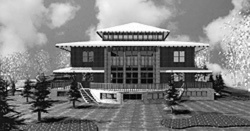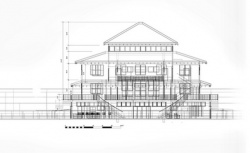The Dragon Hall
To row a boat or to construct a bridge over a river is equally the bodhisattva’s practice of giving. If you study giving carefully you realize that living as well as dying are both giving. To be sure, to make a living and regulate a business is none other than giving. Flowers are innocently fondled by the wind, and birds trust freely to time— these too are feats of giving…. Indeed, by reason of being originally gifted with the power of giving, one’s present self came into being. —Master Eihei Dogen
This monastery bubbles with ideas and projects. Is it the training, which pushes students and residents to be creative and depend on their inner resources? Is it a natural outcome of a group of people with a similar focus living and working together? Is it something about the land itself, which pulses with energy? Considering how the Monastery has expanded in the last twenty-five years, it is remarkable that thus far we have not undertaken a major construction project and physically expanded to meet our changing needs. That is, until now. The need for more space was recognized as far back as 1985 during the first Board of Governors meeting. That is when the first blueprints for the Dragon Hall were drawn. For the next fifteen years, the plans became increasingly detailed, with the end result being a 9,000 square-foot building that will accommodate many of the Monastery’s activities and resources. For the first time in the Monastery’s history, there will be dedicated areas for art and body practice as well as a large exhibition hall which will have the flexibility to be transformed according to need—from a conference center, to a performance space, to a gallery, to a place to hold our many retreats. The expansion of the library will consolidate and make available the Monastery’s extensive audiotape, CD, DVD, and book collections, facilitating academic study and providing a place for scholarly research. All of these activities will benefit not only the resident sangha and monastics—they will serve the broader community of practitioners as well. A project this large in scale is not launched overnight, so for more than two decades, the building of the Dragon Hall had to be put aside until the time was right to allocate the necessary resources and attention to it. That time is now, and we stand on the threshold of seeing what has been a wish become real. Can we imagine how this building will change our future? What combination of people, creativity and energy will bring this structure to life? What new ideas and opportunities will suddenly seem possible once we have room for them? Places come alive only when they support the vital, inspired activity of hearts and minds. I think of the Dragon Hall and imagine, in the courtyard, an ad hoc band improvising on guitars and a shakuhachi. In the lounge area, three people writing poetry together. In the computer room, a resident composing a newsletter on environmental activism while, one floor below, the Zen teens put the finishing touches on a movie. But perhaps the most important aspect of the Dragon Hall is how it connects with the existing Monastery. Literally within sight of each other, these two buildings will remind us of where we come from and the open potential of where we are going. How do we continue to walk in harmony with both the past and the future of this dynamic Buddhist practice? Buildings are acts of expression, constantly revealing the seed of intent that began them. Dreams of big money seem to produce one type of building and dreams of beauty another. Look for example at the main Monastery building itself. Brought into being by Father Joseph Scully in 1929, I am sure he never imagined the many changes of ownership and the different religious organizations that would call this place home and yet, despite all the shifts, this place continues expounding its original purpose. As I look everyday at the intricate stone building, I think of the strength of purpose that caused it to come into being. How remarkable!
Ideally, religious spaces put us in touch with the deepest aspects of our human experience. They are among the most evocative forms of architecture; places that connect us to the hidden and the intangible in everyday life, to a sense of mystery and potential. Cathedrals do this with grand, arching overtones and chapels with simple grace. Buddhist temples, with their simple, elegant lines and stone stupas, keep us close to the ground. Our own monastery, solid and beautiful, seems to me to be a poem in stone, wood and iron, an ode to creative imagination. With each hand-hewn beam and lovingly crafted hinge and bolt, I see the power of vision and dedication, not just of one person, but of many people. That is the beauty of working on something as large as a building. It necessitates the merging and expansion of many visions into one. Perhaps that is also why we build. Perhaps deep within us there is a recognition that any idea, to fully live, must grow and change, and thus must be given away so that it no longer remains personal, but instead lives and interacts with other hearts and minds. In one of his talks, Daido Roshi quotes the following phrase: “Dragon sons and daughters are born of dragon parents.” With the Dragon Hall, we have an opportunity to follow Father Scully’s lead and create a place that will inspire future generations to discover new ways to bring to life and make available the vibrant teachings of the buddhadharma in 21st century America. Let us take up this challenge with spirit and imagination, yet grounded in the principle of true giving.
Anne Walker has worked as an art installer for many years. She is currently in a year-long residency at the Monastery. Architectural designs by Michelle Yoshin Laccadito, MRO. Fundraising for the Dragon Hall will begin summer of 2006.

